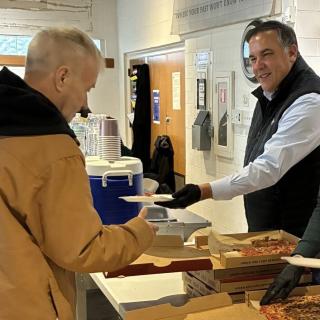#Nuclear War, #Armageddon, #Doomsday Clock, #Nuclear Waste, #Nuclear Meltdown, #Nuclear Arms Treaty, #Nuclear Disarmament; et al
You probably haven’t read much in depth news coverage about nuclear war, right? Nuclear holocaust, like Climate Change and the possibility of an uninhabitable earth for human civilizations — or is it the probability? or inevitability? Both “topics” are too big, too scary, and most eyes and ears would likely ignore the “story” or change the channel.
And yet, we are all aware of these topics. Putin and Trump both make threats about the escalation beyond drone warfare, the new norm, to the use of “small scale” or “tactical” nuclear weapons designed for battlefield use rather than strategic destruction, with yields from less than 1 kiloton (1000 tons of TNT) to tens of kilotons. How small are these weapons, you might ask? They’re small enough to be deployed by individual soldiers.
Scary indeed. My mind was blown recently when I learned from military experts that the reason why Russia is making such progress in Ukraine, despite having lost so many hundreds of thousands of soldiers in the first phase of the war using tanks and trenches, is because they are now deploying small groups of 3–5 soldiers carrying drones that swarm with AI guidance to smash their targets. Ah, new technologies arrive to disrupt and change the “game.”
And similarly, the new technologies of geoengineering have emerged to save our planet from global warming. If these fail, our tech bros are planning to move to space stations and inhabit the moon and mars, and while there grab some mineral resources to sustain the techno-sphere.
But hiding in plain sight are voices vying to be heard above the din of global consumer culture. “Let us not talk falsely now the hour is getting late,” quoth Bob Dylan in his album All Along the Watchtower.
First up, Libbe HaLevy produces a terrific podcast / weekly newsletter called Nuclear Hotseat. In Columbus Ohio I first heard Libbe on our low power FM radio station WGRN 91.9 and streaming on WGRN.org, the Green Renaissance. If you, like me, oppose nuclear in all its many forms, this is where you will find quality news, expert interviews, and an unabashed, oppositional perspective on weapons, reactors, radioactive waste production, taxpayer bailouts to for-profit nuclear corporations, and all other aspects of the industry. More here. You can get a free excerpt from her book online or you can buy the book, Yes, I Glow In the Dark! One Mile from Three Mile Island to Fukushima and Nuclear Hotseat for $20 from Amazon or from the nonprofit Bookshop.org.
Next, I recommend Annie Jacobsen, a Pulitzer Prize winning journalist who who has written several books on nuclear war and secret government operations over the past 20 years. She has written about the Pentagon’s Brain, First Platoon: A Story of Modern War in the Age of Identity Dominance, and most recently, Nuclear War: A Scenario. Her book combines historical analysis of U.S. nuclear war planning with a minute-by-minute account of a hypothetical first strike by North Korea against the United States, showing how the conflict escalates to global thermonuclear war within 72 minutes, leading to nuclear winter and 5 billion deaths. If you dare, read more here.
The Cuban Missile Crisis
As an octogenarian, I happened to be a student at Antioch College working on a co-op job in Washington DC in the fall of 1962 during the Cuban Missile crisis. My fellow roommates from Antioch and George Washington University lived in a large house a block and a half from the White House. Several us demonstrated outside the White House (when that was allowed) as part of the Student Peace Union’s campaign for Unilateral Nuclear Disarmament.
Briefly, for younger readers, the Cuban Missile Crisis began when the U.S. discovered that the Soviet Union was secretly building nuclear missile sites in Cuba. For 13 days the entire world was suddenly and dramatically aware that an imminent threat of nuclear war was unfolding before our collective eyes, all glued to our tv tubes. The crisis ended after a secret deal was struck between John F. Kennedy and Nikita Khrushchev. The Soviets agreed to remove their missiles from Cuba, and the U.S. agreed to remove its nuclear missiles from Turkey and promised not to invade Cuba.
I can’t overstate the intensity of this experience for me personally. The crisis was a wakeup call that led to worldwide demonstrations, lobbying efforts, nuclear test bans, and treaties established to limit the nuclear arms race. While unilateral disarmament never happened, demands for disarmament from large popular movements were crucial in putting pressure on the countries involved to disarm during the Cold War. In the 1980s, the Nuclear Freeze Campaign, for example, organized a march of one million citizens in New York City.
After the collapse of the Soviet Union in 1991, anti-nuclear movements focused on more targeted issues. For example, treaties to limit the proliferation of nuclear weapons to more nations, concern over the spread of nuclear weapons to terrorist groups, and some organizations changed their focus to nuclear power. For many reasons there has been no mass movement to address nuclear disarmament during the past three decades. See Dan La Botz’s article, Why Is the Anti-Nuclear Movement Today So Weak?
New Back from the Brink Movement Advocates for the End of Nuclear War
The fact that President Donald J. Trump is the ONLY person with the authority to push the button and start a nuclear war is reason enough to welcome the new Back from the Brink movement.
Back from the Brink is organizing and leading a renewed advocacy for the end of nuclear war. https://preventnuclearwar.org/ Browse their website to learn about their mission, proposed legislation, and find out which states, municipalities, and legislators are already on board.
Back from the Brink calls on the United States to lead a global effort to prevent nuclear war. In order to do so, we urge the U.S. to enact these five policy solutions:
- Pursue global elimination of nuclear weapons through a verifiable agreement among nuclear-armed states to eliminate their nuclear arsenals
- Renounce the option of using nuclear weapons first
- End the sole, unchecked authority of any president to launch a nuclear attack
- Take U.S. nuclear weapons off hair-trigger alert
- Cancel the plan to replace the entire U.S. arsenal with enhanced weapons
These policy solutions are outlined in our congressional resolutions — H. Res. 317 in the U.S. House and S. Res. 323 in the U.S. Senate. Learn more about supporting our resolutions.
Back from the Brink was conceived and initiated by leaders from the Union of Concerned Scientists (UCS) and Physicians for Social Responsibility (PSR) in the fall of 2017.
“Today, the risk of nuclear catastrophe is greater than ever before, but we need not accept this fate as inevitable. Back from the Brink represents a crossroads, blazing a new trail with concrete steps to take us away from danger and towards a safer future for humanity. The fight against the threat of nuclear weapons can be daunting, but BftB has created a worthy roadmap for battle.”
~ William J. Perry
19th Secretary of Defense



